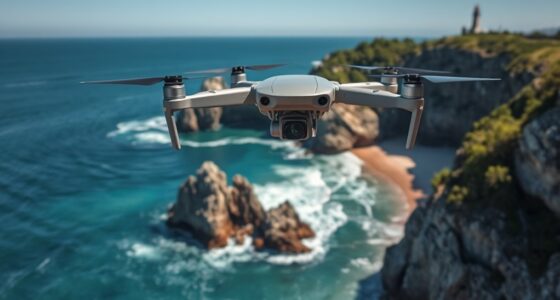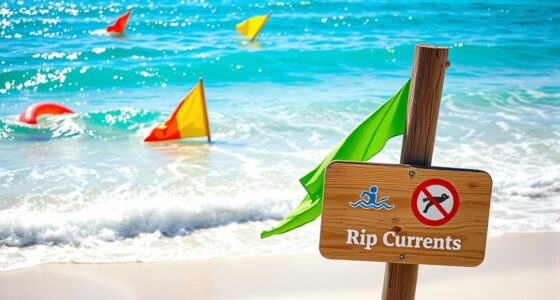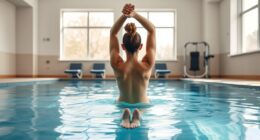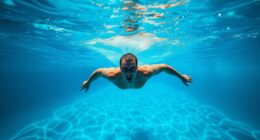To track your distance while floating without gadgets, focus on identifiable, evenly spaced landmarks such as lane markers, buoys, or natural features. Count each landmark you pass at a steady pace, multiplying by the known distance between them for an estimate. Keep your pace consistent and your counts accurate by pausing if needed. With practice, you’ll develop a good sense of your swim distance—continue exploring for more helpful tips.
Key Takeaways
- Identify and count stationary landmarks, such as lane markers or natural features, passing them during your float.
- Measure the distance between landmarks beforehand using a map, GPS, or known measurements.
- Maintain a steady pace to ensure consistent landmark passing and accurate counting throughout your float.
- Keep a mental or physical tally of landmarks passed to track progress and prevent losing count.
- Multiply the number of landmarks passed by their known spacing to estimate your total distance traveled.
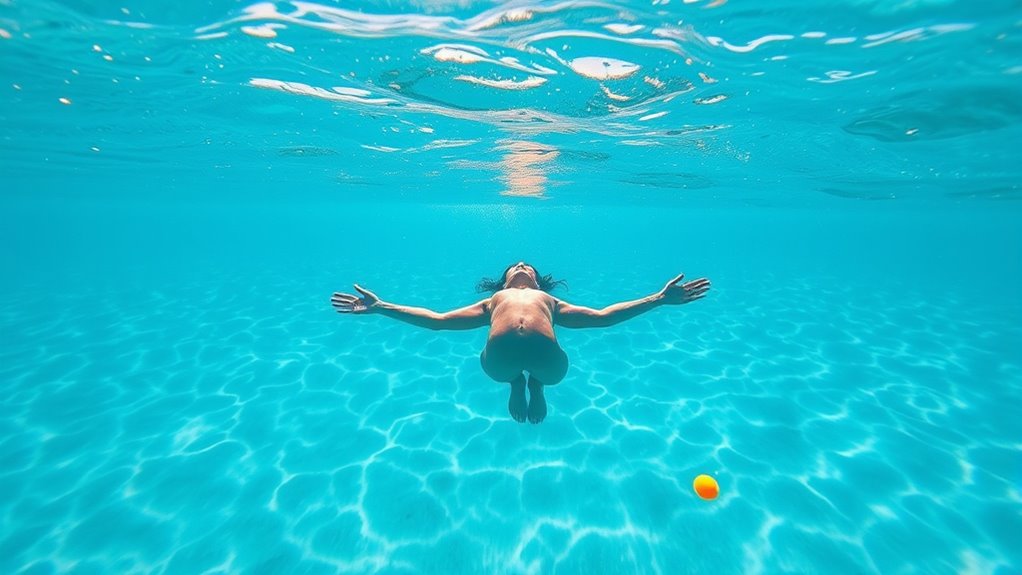
When you’re floating in water, accurately tracking the distance you cover can seem challenging, but it’s entirely possible with the right methods. One effective way to measure swim distance without gadgets is by using floating landmarks. These are objects or points that stay relatively stationary in the water, such as buoys, floating sticks, or markers placed along the poolside or in open water. By noting how many of these landmarks you pass or reach during your float, you can estimate the distance you’ve traveled with reasonable accuracy. To do this well, start by familiarizing yourself with the layout of your environment. If you’re in a pool, identify the lane markers or tiles at regular intervals. In open water, use buoys or natural features like rocks or boat markers. As you float, keep track of each landmark you pass, either mentally or with a simple count. When you reach a landmark, mark the number, then continue until you reach your endpoint. Later, you can multiply the number of landmarks passed by the known distance between each to get an estimate of your total swim distance. This method relies on consistent landmarks so that your measurement remains accurate over time. Regularly inspecting your floating markers for wear and tear is also important for maintaining safety and accuracy during your swim.
Measuring swim distance using floating landmarks is straightforward but requires some preparation. Before your swim, determine the distances between landmarks. For pools, this often means knowing the length of a lane or the distance between tiles. For open water, it might involve measuring the distance between buoys or natural features with a map or GPS measurement beforehand. During your float, focus on maintaining a steady pace and a clear mental count of landmarks passed. Consistency is key. If you lose track, pause briefly to recalibrate or start counting again. This method works best when landmarks are evenly spaced, but even uneven spacing can give you a rough estimate if you keep accurate track of each segment. Using home furnishings like markers or floats can also help create stable landmarks, especially if you’re practicing in a controlled environment. Using floating landmarks to measure swim distance is a simple, tech-free approach that doesn’t require any special equipment. It’s especially useful when you want an immediate sense of how far you’ve traveled without relying on gadgets or apps. By paying attention to your surroundings and keeping a steady pace, you can develop a good sense of your distance over time. With practice, you’ll be able to gauge your swim distances reliably, making your floating sessions more intentional and rewarding. This method helps you stay connected to your environment, enhancing your awareness and control during your water floats.
Frequently Asked Questions
Can I Measure My Floating Distance Without Any Tools?
Yes, you can measure your floating distance without tools by paying attention to float duration and natural signs. Track how long you stay afloat and observe landmarks or natural markers like trees, shoreline features, or passing clouds. Use these cues to estimate the distance traveled. By combining your float duration with natural signs, you can get a good idea of how far you’ve floated without relying on any gadgets.
What Natural Signs Indicate How Far I’ve Floated?
Did you know that water currents can move up to 5 miles per hour? When floating, you can gauge your distance by observing natural signs like changes in water color, the position of floating debris, or the direction of plant growth. Marine navigation relies heavily on water current awareness, so pay close attention to how these signs shift over time. These clues help estimate how far you’ve floated without any tools.
How Do Weather Conditions Affect Floating Distance Tracking?
Weather conditions substantially impact your floating distance. Wind influence can push you off course or speed up your journey, making it harder to estimate distance accurately. Water currents also play a major role, as they can carry you farther or hold you back. You should constantly observe these factors, adjusting your natural signs accordingly. Staying aware of weather changes helps you better gauge how far you’ve floated without relying on technology.
Is It Possible to Estimate Distance Based on Float Duration Alone?
While float duration estimation provides a gentle hint, it’s not a precise measure of distance. You can gauge your journey by paying close attention to environmental cues like water flow, surface features, and your own paddling rhythm. These subtle signals help you understand how far you’ve traveled. Relying solely on float time might lead you astray, but combining it with keen observation offers a more reliable sense of your floating adventure.
Are There Any Safety Tips for Long-Distance Floating?
When floating long distances, prioritize safety by wearing proper safety equipment like a life jacket and carrying emergency signals such as a whistle or mirror. Stay close to the shoreline or a known route, and keep aware of weather conditions. Regularly check your position, and if you feel uncomfortable, signal for help immediately. Always float with a buddy if possible, and inform someone ashore about your plans.
Conclusion
Just like a leaf drifting on a stream, floating freely can make it hard to know how far you’ve gone. But with simple tricks—like counting your breaths or paying attention to landmarks—you can get a good sense of your distance without tech. Stay mindful and relaxed, and you’ll enjoy your float while keeping track of your journey. Remember, sometimes the most natural methods are the best, guiding you smoothly through your floating adventure.



